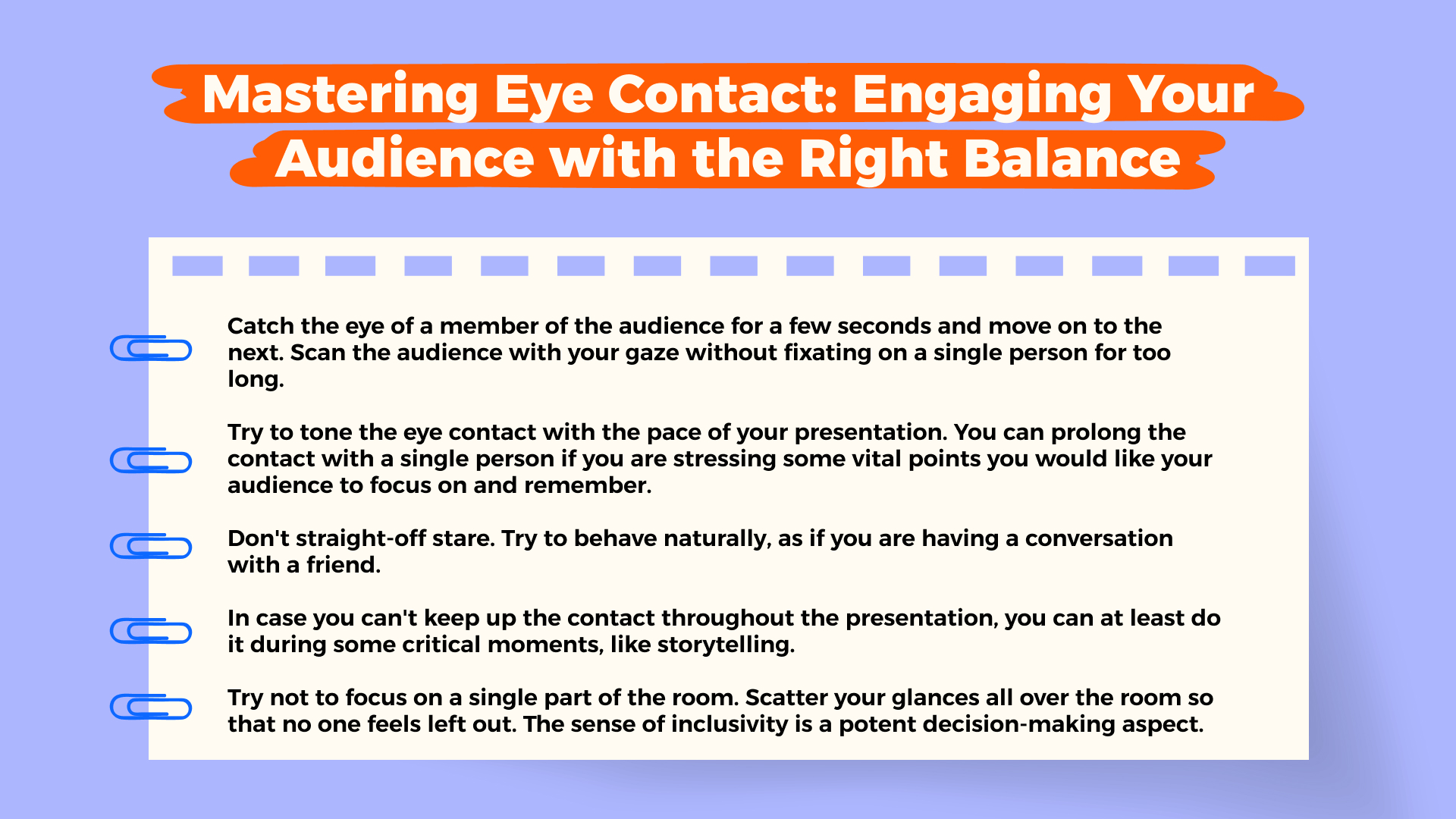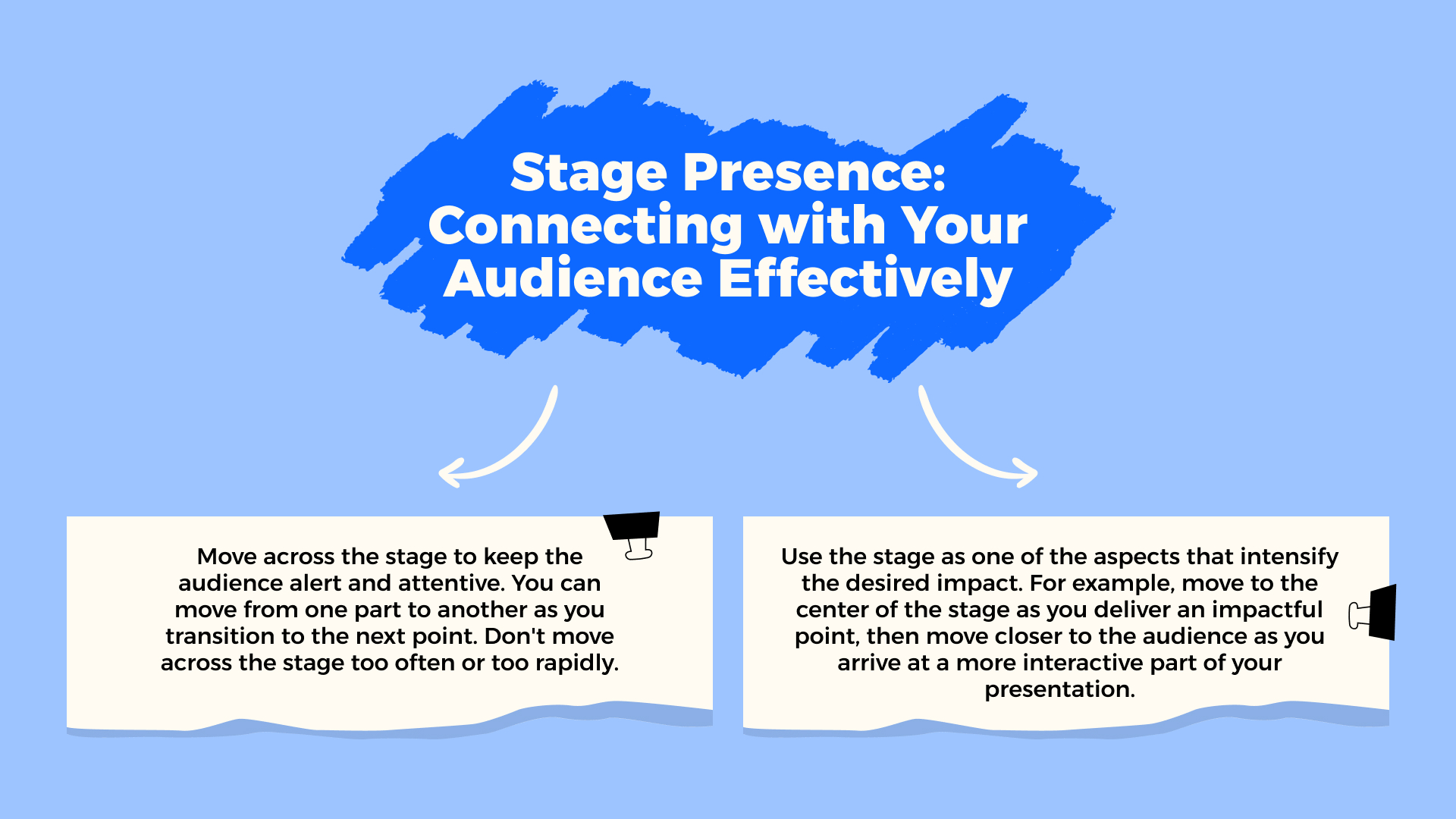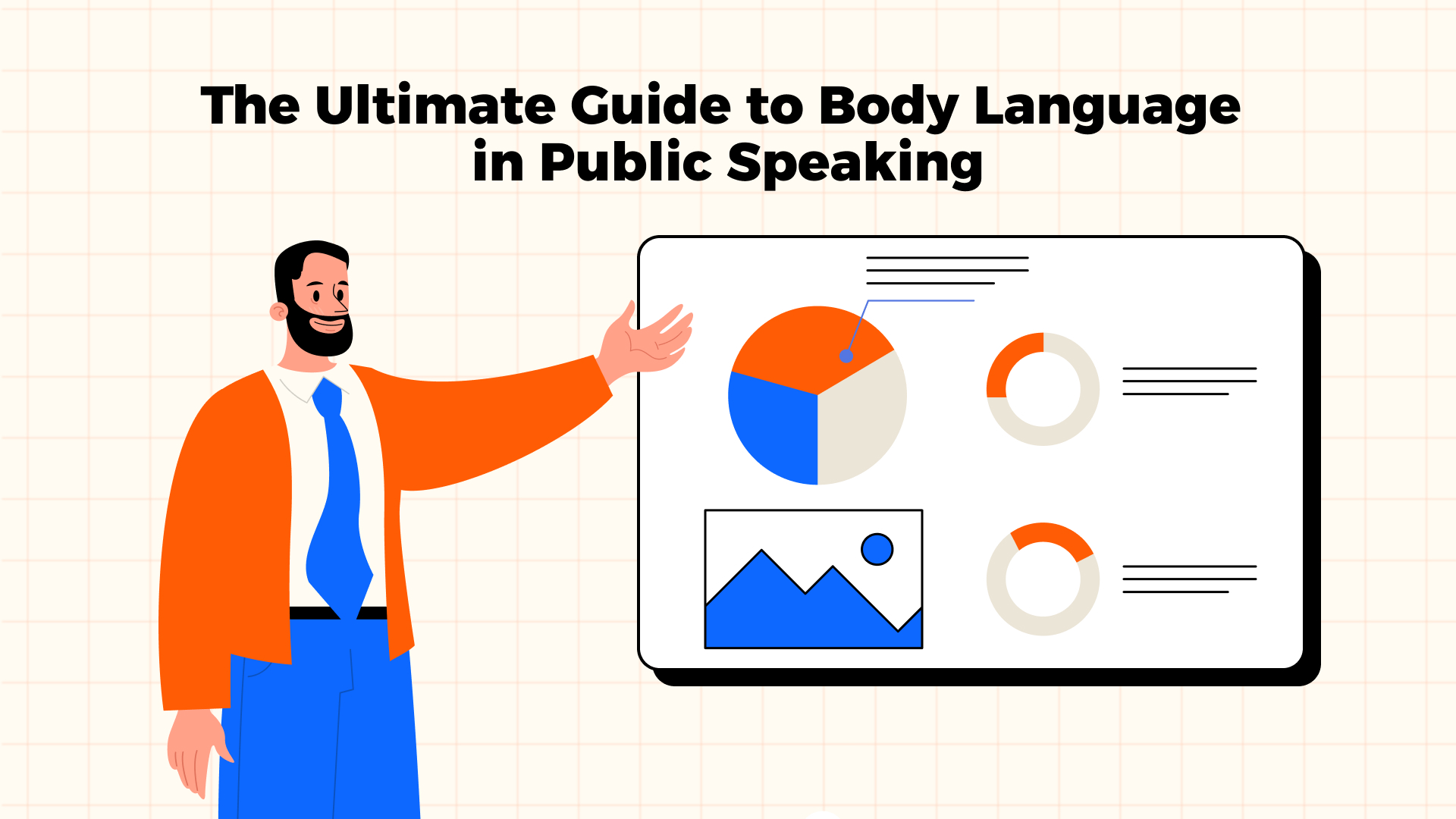Around 75% of people feel uncomfortable speaking in public. What makes over 200 million people fear open communication with others? The list of reasons is quite extensive, yet limited awareness of the power of body language is surely on the list.
Some people still assume that an effective presentation ends with professional presentation design services. However, the vibes that a presenter gives out during the presentation are what usually seal the deal. Since about 55% of communication is non-verbal, your body language will either persuade or dissuade the audience.
Assuming that you aim only at the positive impact of your presentation, our experts have compiled a list of actionable tips and other critical details on how to make the most of your body language in public speaking.
Understanding Body Language in Public Speaking
A famous American actress and sex symbol, Mae West, once said: "I speak two languages – body and English." Let's try to figure out what the main role of body language is and how to make the first impression count.
The Role of Body Language
Body language is a set of non-verbal means we use to deliver our thoughts, ideas, emotions, and intentions. Gestures, posture, facial expressions, and other reflexive or non-reflexive body movements serve as communication transmitters that others can read without prior training.
For instance, hand gestures in public speaking are usually applied to add more dimension to the presentation. As you may know, open palms are a universal sign of honesty. A professional public speaker would use this gesture to indicate the credibility of specific points.
Another excellent example of effective body language is facial expressions. Your face can reflect genuine emotions and connect with the audience faster than you can do it through a dedicated presentation. All it takes is a gentle smile to proclaim your approachability and just a furrowed brow to express concern. Amazing, isn't it?
Back in 1967, a famous psychologist, Albert Mehrabian, published his study "Inference of Attitudes from Nonverbal Communication in Two Channels," in which he emphasized the power and importance of body language. The doctor said that speech mannerisms can either align with your spoken message or contradict it. Most people use body language subconsciously, but in a professional setting, you may need to work a little harder to spread a desired vibe. Yet, everything comes with a fair share of practice.
First Impressions and Stage Presence
It is encoded in human nature to size one another quickly. That is why first impressions matter. The moment a speaker sets foot on stage, the audience starts the evaluation process, which will have a table-turning role when it comes to making a final decision.
Let's imagine a confident presenter who walks in with their back straight, a smile on their face, and direct eye contact with the audience. Such an appearance would set the tone of trust and authority and boost viewer engagement immediately.
On the other hand, a shy, more hesitant speaker who sulks, hunches over and avoids direct eye contact will make the audience doubt the credibility of the presentation regardless of expert pitch deck design, innovative solutions, and revolutionary discoveries.
Key Elements of Effective Body Language
People subconsciously react to confident speakers more positively because they perceive the presenter as a leader model. You can hone your public speaking body language skills and boost your authoritative aura significantly with just a few tricks up your sleeve.
Eye Contact
Strategies for maintaining engagement through eye contact. The balance between too little and too much eye contact.
Eye contact is one of the major components of nonverbal communication in speech. Direct eye contact implies that you lock your eyes with those in the audience throughout the presentation. Well-preserved eye contact is the simplest way to instill trust and confidence in your words. Besides, it promotes the audience to be more active and more involved in the presentation.
How do you achieve the desired result? Surely, you can't stare minutes at length into someone's eyes. It will have a slightly intimidating and compromising effect. Instead, you can try practicing these simple tips to improve the positive impact of your body language:
- Catch the eye of a member of the audience for a few seconds and move on to the next. Scan the audience with your gaze without fixating on a single person for too long.
- Try to tone the eye contact with the pace of your presentation. You can prolong the contact with a single person if you are stressing some vital points you would like your audience to focus on and remember.
- Don't straight-off stare. Try to behave naturally, as if you are having a conversation with a friend.
- In case you can't keep up the contact throughout the presentation, you can at least do it during some critical moments, like storytelling.
- Try not to focus on a single part of the room. Scatter your glances all over the room so that no one feels left out. The sense of inclusivity is a potent decision-making aspect.

Facial Expressions
Facial expressions are equally essential when you try to tune your body language and public speaking impact to deliver the right message. Smiles, nods, eye movements, and facial variations will help you build rapport if you expertly incorporate them into your presentation.
How do you align your facial expression with your message?
- Determine the emotional tone of your presentation. Whether it is excitement, enthusiasm, determination, or empathy, you should reflect these emotions on your face.
- Use your eyes to project emotions. You can widen your eyes in awe or squint them when you are feeling doubtful, etc.
- The mirror effect will come of use, too. Match your facial expression with the sentiments you are trying to project.

You shouldn't underestimate the power of smiles and strategic nods. For instance, a warm smile will create a positive environment and spread the vibes of openness and approachability, all aspects critical for a strong connection with the audience.
When you learn how to speak eloquently, you must realize that the viewers monitor your demeanor closely to form a better opinion of what you are presenting. If you nod in agreement or understanding as you highlight the main points, the audience will feel prone to further engage in the process. Yet, it is easy to take the nodding over the edge and spread insincerity instead of any positive impact. That is why you must avoid repetitive or out-of-the-place nods.
Gestures
Such speech gestures as hand gestures may be the easiest to master, yet they can let you down if you don't know about the common pitfalls to steer clear of. It is a good idea to use your hands when you arrive at a certain point to induce memorability. You can also rely on hand gestures to complement the verbal message. However, it is critical to maintain the natural appeal of your gestures in public speaking. When you try to incorporate rehearsed movements and gestures into your speech, the audience will see it and treat it as ingenuity and deceit.
There are two main gesture pitfalls to avoid:
- Moderation
- Fidgeting
A person who fidgets all the time will distract the audience since they will be observing your movements rather than paying attention to what you are saying. The same goes for overly exaggerated and rapid gestures. Natural flow, consistency, and moderation are the main pillars on which to base your hand gesture presentation.
Posture and Movement
Your posture can become an effective mannerism in speech. A confident and grounded stance signals expertise, focus, and authority. Keep in mind that this refers to both the speaker and the audience. A power stance is relatively easy to master. All it takes is to stand tall on the ground, shoulders back, feet shoulder-wide. Try to distribute your weight evenly and minimize the swaying to gain balance and exude assurance.
Some speakers add a bit of dynamics to their stance. The dynamics may vary from presentation to presentation, but the general rule remains – lean forward when presenting key points to boost engagement and step back when conveying reflection.
Don't forget about strategically planned movements. You should learn how to use your stage as one of the means to connect and engage with the audience:
- Move across the stage to keep the audience alert and attentive. You can move from one part to another as you transition to the next point. Don't move across the stage too often or too rapidly.
- Use the stage as one of the aspects that intensify the desired impact. For example, move to the center of the stage as you deliver an impactful point, then move closer to the audience as you arrive at a more interactive part of your presentation.

Practicing Effective Body Language
Practice makes gestures in a speech more effective with every other presentation. So, where do you start?
Techniques for Improving Body Language
List specific exercises for posture improvement and gesture control. Emphasize the importance of practicing in front of a mirror or recording presentations for self-review.
A few people can show off perfect control over their body language in speech without constant practice. There are a few practical techniques you can use to improve your posture and gesture control.
Exercise 1
Stand in front of the mirror and observe your posture. Pinpoint aspects that you don't feel optimistic about. Straighten your back, place your feet firmly on the ground, relax your shoulders, and make other necessary adjustments to feel confident and authoritative.
Exercise 2
As you wonder about how to write an outline for a presentation, you should think about gestures for speeches you plan to refer to during it. Once you point out the main gestures, try to practice them in front of the mirror, aligning them with the context you will present.
Exercise 3
Stand in front of the mirror and try to shift your weight between the feet. Practice until you strike a perfect balance, and try to memorize how the stance feels.
These exercises may seem a little too simple, but that does not undermine their effectiveness, especially if you practice regularly. However, it is possible to take things a little further and video-record yourself. A video of your gestures, stance, or expressions will help you see how you look from the side so that you can introduce necessary corrections and fix potential errors.
Another effective option is to ask your peers or colleagues with experience to watch you present and share their thoughts and opinions on what can be improved.
Integrating Body Language with Verbal Communication
.jpg)
It takes time and effort to align your verbal and non-verbal communication. Still, the final result is worth it since such a synchronization will enhance the impact of your message and make it resonate with the audience.
Effective strategies for perfect alignment:
- Scan your presentation and pick a few major points. Evaluate these points and think about which body language gestures could promote them. Practice them in sync.
- Define prevailing emotions in your speech. Consider expressions and gestures that reflect them best. Whether it is joy, concern, or doubt – amplify those with your demeanor.
- You may practice your speech and body language separately for a while, but it will be most efficient to practice two at once. There are a few tested methods to succeed with the goal:
→ Practice your presentation along with the body language in front of the mirror.
→ Practice in front of the camera. Review the recording to determine your strong and weak points.
→ Practice mock Q&A sessions with friends or colleagues to inspire spontaneous gestures and test how well you are prepared for interactive engagement with the audience.
Advanced Body Language Tips for Professional Speakers
Professional speakers know how to use gestures for public speaking to achieve multiple goals.
Reading and Reacting to Audience Body Language
Well-practiced presentations are the first step to delivering the most impactful speeches. However, sometimes, you need to be ready to make real-time adjustments because the audience behaves in a different way than you expected.
The first rule to remember is "read and react." When you see that your well-prepared presentation does not have the desired effect, you should scan the audience to catch their mood and align your body language to their requirements. Here's how it works:
- Observe the primary body language of the audience. Pay attention to postures, facial expressions, or gestures to adjust.
- Consider your pace. If you see that the viewers keep up with the pace of the presentation – continue. However, in case you notice that the audience feels lost or confused, slow down a bit.
- Read the overall mood. If the audience is positive, you can increase the amount of engaging body language elements. If not – try to tune it down a notch.

Keep in mind that sometimes your audience may be straight-off disinterested and even hostile. While an untrained speaker would be demotivated to continue the presentation, it is possible to try and turn the tables through effective communication based on a speaker's body and voice.
Disinterested audiences can be manipulated into genuine engagement through approachability. A smile here, a nod there, open gestures, and eye contact promote friendliness, and most people subconsciously respond to that.
If your viewers disagree with you, don't try to cut them off, this will only intensify the hostile vibes among the audience. Show them that you are open to different perspectives and promote sensible discussions.
When you see members of the audience slowly drifting away and losing their interest, you can try and move a little closer to them to re-engage them. Do not come too close, hovering over them just a step closer in the chosen direction will be enough. The same goes for eye contact. Try to catch the eye of someone who seems disengaged and move on.
Body Language for Persuasive Speeches
You can make any presentation twice as convincing if you use your body language effectively.
Practical techniques for conveying authority:
- Direct eye contact for a strong connection
- Power stance for authority
- Controlled speaking gestures for persuasion
On top of that, you can also reinforce separate elements of your presentation with body language:
- Lean forward during a compelling argument
- Draw attention to a specific subject with open hand gestures
- Use posture transitions to indicate that you move on to another thought, subject, or idea
- Indicate the urgency or importance of the message through strategic eye contact
Common Body Language Mistakes to Avoid

As effective as some gestures of body language are, they can be so destructive when used incorrectly. Let's outline a list of the most common mistakes to avoid when using hand gestures and body language in public speaking.
- Crossed arms – this is usually a sign of defensive behavior. This gesture will only build a wall between you and the audience. It is advised to keep the arms open and relaxed to promote a sense of approachability.
- Lack of eye contact – this will signify to the audience your insecurity, nervousness, incompetence, disinterest, and whatnot. Direct eye contact, in its turn, inspires trust and engagement.
- Constant pacing – if you move a lot, it will serve as a distracting factor rather than a persuasive act. Choose a comfortable pace that does not affect the audience's concentration.
- Nervous habits – nothing indicates anxiety more clearly than aimless fidgeting. Suppose you are prone to pointless playing with objects or finger tapping, practice to minimize, if not eliminate, these habits since they will only undermine your expertise and distract the audience.
- Poker face – lack of facial expressions will make you look less of a human and more of a robot. Robots don't impose emotional bonds and connections, and these are significant factors that make any presentation successful or otherwise. Whether you are ending a presentation with impact or delivering a core message of your speech, make sure that your face corresponds to those emotions encoded in the content.
Conclusion
Why is body language important in a speech? The answer is quite simple – it is one of the keys to making a lasting impression that drives the audience towards preferable decisions. There are various types of body language you can master. Each of them is equally effective, but when used unanimously, they can boost the impact of your message the way no expertly written content can, although they work in sync.
Today, we've enclosed a fair share of tips, techniques, and methods on how to find, explore, and enhance your body language. Now, what's left is to put enough practice into these means of effective communication and become a strong, confident, and persuasive presenter!
In case you want to learn about what is a slide deck presentation or find inspiring handout ideas for presentations topped with practical advice on the best presentation font size, check out Whitepage's blog for more helpful information!
.svg)

.svg)

.svg)














.svg)
